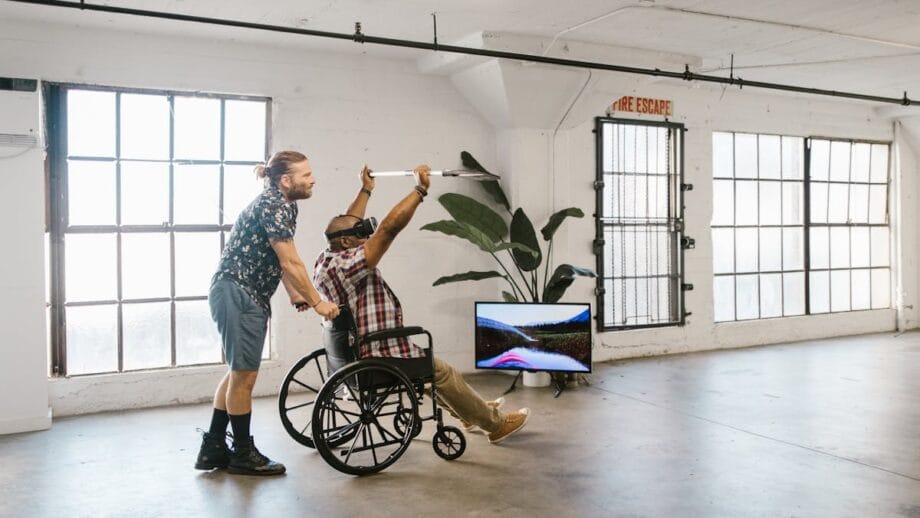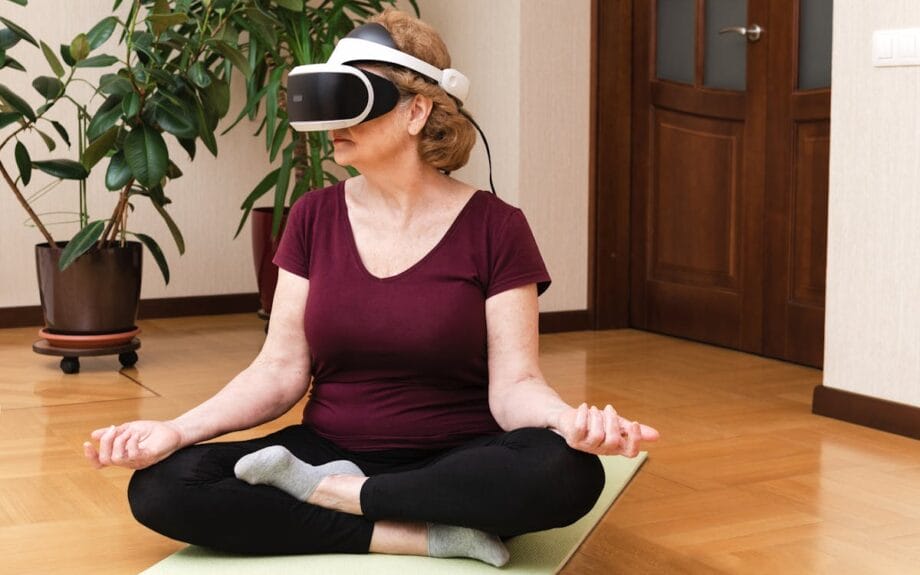Finding new ways to improve healthcare is always a challenge. People are searching for methods that make treatment better and learning easier for professionals. One exciting solution is virtual reality (VR).
This technology takes users into a simulated world. It can change how we see healthcare.
VR has grown from just games to helping doctors and patients in many ways. For example, VR helps surgeons practice operations without risks. It creates a safe space for mental health treatment too.
Our blog will show you 7 areas where VR is making big changes in healthcare. Discover how it’s easing pain, training doctors, and helping patients recover faster.
Get ready to explore the future of healthcare with us.
The Evolution of VR in Healthcare

The journey of VR in healthcare has picked up speed, thanks to leaps in technology. The 21st century brought significant growth in virtual and augmented realities. This progress means doctors and medical students can step into a simulated environment for surgical training without real-life risks.
It opens doors to safer learning spaces where errors are part of the learning curve, not a life-threatening event. The University of Southern California Institute for Creative Technologies leads this push into new territories, exploring how these tools can better serve both patients and professionals.
VR takes mental health therapy beyond traditional settings by offering exposure therapy in a controlled virtual space. Patients facing phobias or PTSD can confront their fears safely under professional guidance.
This method shows promising results in reducing symptoms more effectively than some conventional approaches. Pain management also sees innovation through VR by distracting patients during painful procedures, making it an invaluable tool across various healthcare sectors from neurorehabilitation to chronic pain relief.
“Advances in technology have pushed the boundaries of how we view and interact with the world, bringing revolutionary tools to the forefront of medicine.”
Important Places Where VR Can Revolutionize Healthcare
VR is changing healthcare in big ways. It helps patients and doctors in many areas like training, mental health, and managing pain.

1. Mental Health and VR Therapy
VR therapy is changing the way we tackle mental health issues. Applied VR has developed a tool called Anxiety RelieVR for stress therapies. This shows how virtual environments can aid in treating phobias and other mental conditions. In fact, VR technology is being integrated into EMDR training (eye movement desensitization & reprocessing), assisting therapists to deliver more effective and immersive trauma treatments.
Patients put on VR headsets to enter controlled settings where they feel safe. Here, they can face their fears gradually or re-experience traumatic events without real-world risks.
This form of treatment uses immersive experiences to help people with post-traumatic stress disorder (PTSD), depression, and anxiety. For example, therapists use virtual reality exposure therapy (VRET) to recreate stressful situations that patients can navigate safely.
This method allows individuals to process and manage their reactions in a secure space, which is crucial for healing. The goal is not just about confronting fears but also learning coping mechanisms in a manageable and supportive environment.
2. Surgical Training and Simulations
Surgical training and simulations have significantly advanced with the advent of virtual reality (VR) platforms like OssoVR. These platforms provide medical professionals with realistic practice sessions for surgical procedures without the inherent risk of actual operations.
They employ VR to create immersive settings where surgeons can refine their skills, adopt new methods, and perform high-risk surgeries securely in their procedures.
Remote learning has become more reachable through these VR systems, offering healthcare professionals from various geographical locations the opportunity to collaborate and exchange knowledge in a virtual environment.
This innovation improves surgical training, but it also betters patient care by more thoroughly preparing surgeons for real-world situations.
“Virtual reality in healthcare presents an extremely useful tool for medical education, providing risk-free, engaging learning experiences.”

3. Virtual Reality for Pain Management
Virtual reality (VR) is changing pain management in healthcare. It offers a way to handle discomfort without using drugs. This method works well for people dealing with long-lasting pain.
VR tools like Pain RelieVR are helping during childbirth, making it less painful.
Using VR can also make patients feel more at ease during tough procedures by lowering their anxiety and pain levels. This leads to better experiences for patients and increases their satisfaction with the care they receive.
Through immersive environments, individuals can distract their minds from the pain, focusing instead on virtual scenarios that promote relaxation and comfort.
4. Telemedicine and Virtual Reality Consultations
Telemedicine uses advanced technology to share patient data remotely, making healthcare more accessible. It uses 3D video calls for consultations, breaking down the barriers to accessing medical care.
This method allows doctors and patients to meet in a virtual world, improving communication.
Virtual Reality (VR) takes telemedicine further by creating immersive experiences for both doctors and patients. During a VR consultation, patients can describe their symptoms as if they were face-to-face with their doctor.
This tech also lets specialists from different locations work together on complex cases without having to be in the same room.
5. Rehabilitation and Physical Therapy
Virtual reality (VR) is revolutionizing rehabilitation and physical therapy for patients in need. Technologies such as MindMaze are assisting stroke recovery patients by simplifying the reacquisition of lost motor skills.
This immersive method extends beyond mere exercise by creating a virtual environment where patients can safely work on movements. This controlled digital space allows people to improve their balance, coordination, and strength without the associated real-world risks.
For individuals suffering from Parkinson’s disease, VR offers the potential to better improve balance skills crucial for everyday tasks. Applying VR in therapy provides simulations of genuine scenarios that challenge patients in a manageable and quantifiable way.
Patients interact with these virtually crafted scenarios using tools like HTC Vive headsets which monitor their progression over time. This therapy style offers both physical advantages and invigorates self-assurance as participants observe their own progress during these interactive sessions.

6. VR in Physical and Cognitive Therapy for Neurological Disorders
Doctors use Virtual Reality (VR) tools like MindMaze to help patients recover from strokes. This technology has shown remarkable results in improving how patients walk and balance.
People with Parkinson’s disease also benefit from VR programs aimed at enhancing their mobility. These achievements are often measured by tests such as the Berg Balance Scale (BBS) and the Timed Up and Go (TUG) test, which assess a patient’s balance and speed of movement.
This approach to therapy offers a promising path for treating various neurological disorders through engaging exercises that mimic real-life activities. Patients perform these tasks in a virtual environment, making therapy sessions more interesting and motivating them to practice regularly.
The improvements observed in patients’ physical abilities indicate that VR can significantly enhance traditional therapy methods for neurological conditions, offering hope for faster recovery times and better overall outcomes.
7. VR for Patient Education and Preparation
Virtual Reality (VR) is a valuable tool in patient education and preparation. It provides an immersive medium for patients to comprehend their health issues, allowing them to visualize their internal physiological functions, which simplifies the understanding of intricate medical information.
For instance, a virtual journey through arteries can illustrate the impact of obstructions on blood circulation. This type of immersive learning helps mitigate fear and unease before medical procedures.
Furthermore, VR assists in prepping patients for operations or therapies by mimicking the procedure steps in a virtual scenario. Experiencing a simulated run-through of an impending treatment in a controlled virtual setup considerably reduces stress levels.
Research indicates this sort of preparation contributes to improved results as patients feel more aware and at ease about the course of events. VR has the potential to improve mental readiness as well as the overall hospital journey, a fact supported by pilot studies where all participants reported a decrease in anxiety and pain sensitivity post-VR simulations prior to treatments.
Challenges and Limitations of VR in Healthcare

The expensive nature of equipment and software presents a substantial impediment to the integration of virtual reality within healthcare environments. Healthcare facilities often operate within stringent budgets, making the acquisition of such cutting-edge technology a challenge for many.
This situation results in fewer patients reaping the advantages of VR therapy or training. Furthermore, the likelihood of developing an addiction presents a concern, particularly when VR is employed for protracted treatments of issues such as mental health disorders.
Another concern involves the disorientation users may experience post-VR system usage, potentially causing unease or even mishaps if not appropriately supervised. The absence of physical feedback within virtual spaces complicates the ability of medical students to fully comprehend their surgical procedure simulations, this may compromise the level of their training.
Finally, due to limited trials and its relatively recent introduction, some medical professionals exhibit reservations about incorporating VR extensively within their practice. These issues require solutions before VR can achieve broader acceptance within global healthcare sectors.
The Future of VR in Healthcare
The future of VR in healthcare looks promising with the integration of AI, multiplayer scenarios, and better realism through touch feedback and voice commands. These improvements will transform how doctors train, bringing them closer to real-life experiences without any risks.
Imagine surgeons practicing complex operations or diagnosing patients using advanced VR simulations before stepping into an actual operating room. This leap in medical training is a game-changer. VR’s role in healthcare will only grow. Patients dealing with chronic pain or undergoing difficult procedures could find relief and understanding through immersive VR experiences.
For instance, someone with severe asthma could learn about their condition and manage symptoms more effectively in a controlled virtual environment. As technology progresses, these applications extend far beyond current uses, offering new ways to treat illnesses and improve life quality for millions worldwide.
Endnote

Virtual Reality (VR) is changing healthcare in many ways. From helping people with mental health conditions to training future doctors, VR makes processes better and learning deeper.
Have you thought about how these tools can be part of your practice or care? Using VR for things like patient education and easing pain shows how tech improves lives. More resources on using VR effectively are out there, ready for those who want to learn.
Let’s make healthcare better together by embracing these revolutionary technologies.





